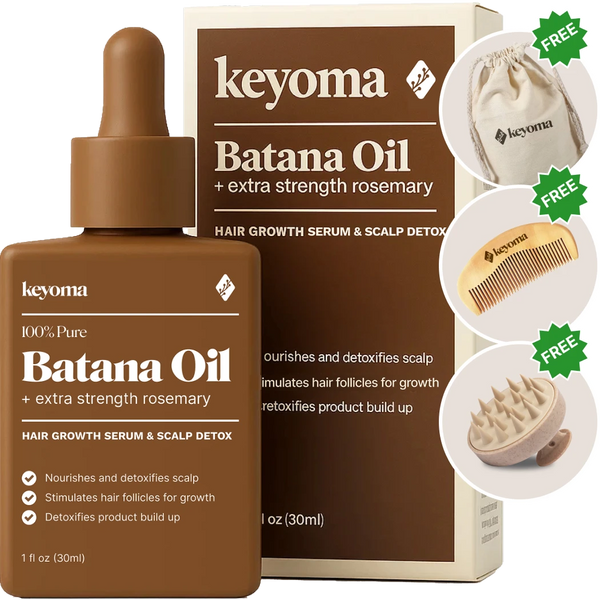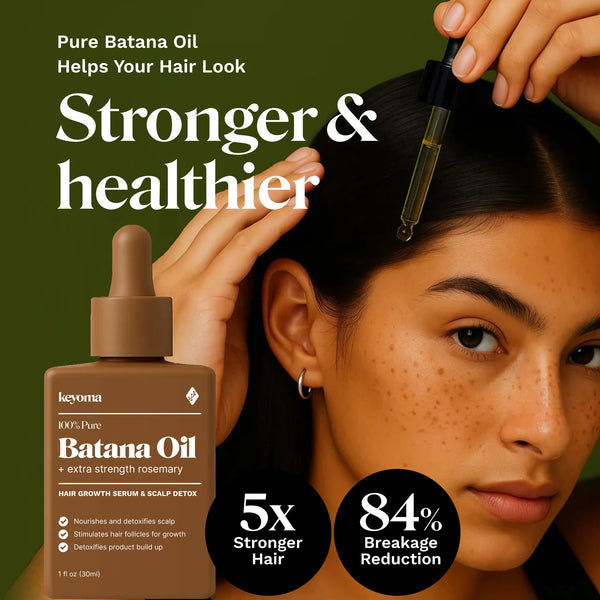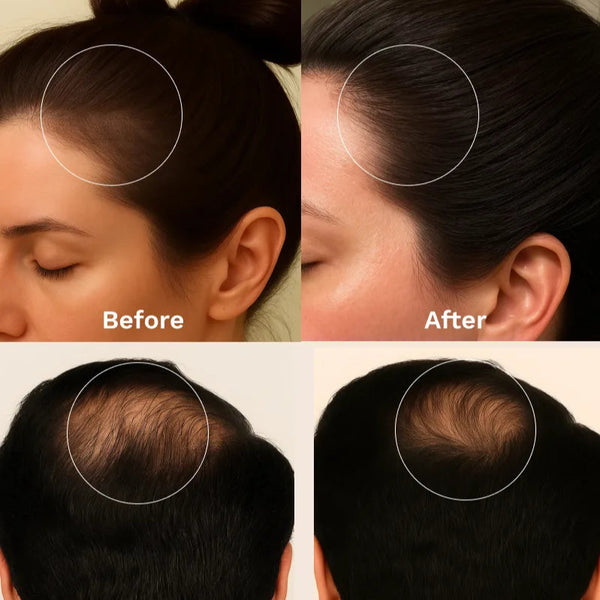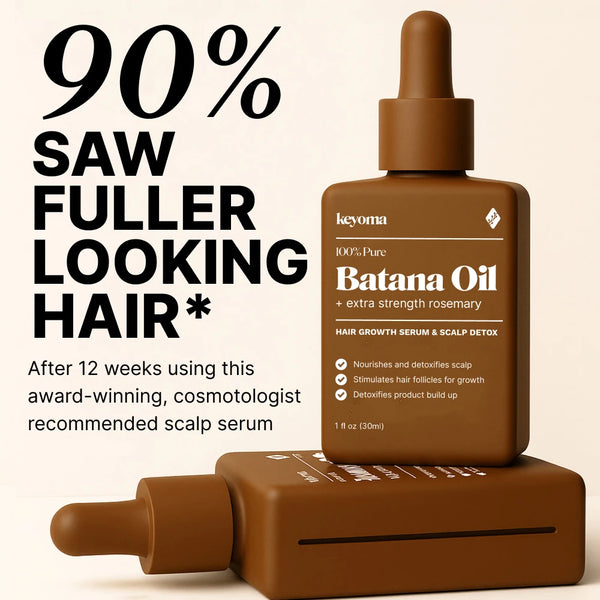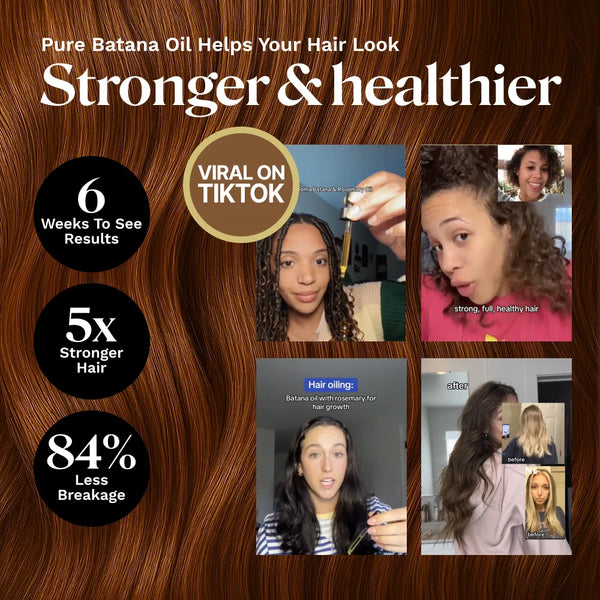In this article
Mary is that Latina woman who gets stopped in the grocery aisle or at family gatherings because of her thick, shiny curls, with strangers often reaching out to touch her dark hair without asking—not in a creepy or harmful way, but out of sheer amazement at the volume and bounce.
What most people don’t realize is that beneath those compliments, Mary shares the same worries many of us do—hair loss. And those worries only grew after she came across research suggesting Hispanic women may be at higher risk for certain hair conditions.
So what does the research actually say? That’s what I’m here to walk you through. Keep reading to learn the real facts about hair loss in Hispanic women—straight from those studies—and the steps you can take to protect your own hair health.
Key Takeaways
-
Hispanic women may face higher odds of conditions like alopecia areata. Research on how their hair ages is still lacking.
-
Cultural habits such as years of tight hairstyles and the stress of work or family demands can gradually lead to thinning.
-
Medical issues like thyroid disease or scalp psoriasis need professional care, since ignoring them can worsen both health and confidence.
What Research Says About Hair Loss in Hispanic Women
Does ethnicity affect hair loss? For Hispanic women, the evidence we have shows higher odds of certain conditions such as alopecia areata, while other areas, like how hair naturally ages, remain largely unstudied.
Hispanic Women Show Higher Risk for Alopecia Areata
A 2018 study of more than 80,000 U.S. women (the Nurses’ Health Study II) found that Hispanic women had almost double the odds of reporting alopecia areata compared to white women.
So, if you've noticed thinning or patchy hair, you're not alone. Because if there's anything that this research tells us, it's that hair loss isn't just an individual issue but rather a real concerning trend in the greater Latina community.
And that makes early early hair care even more crucial.
Hair Loss is Common Among Hispanic Women in High-Stress Roles
A 2010–2022 study of U.S. military service members, which tracked medical records over more than a decade to see how often women were diagnosed with alopecia, found that Hispanic women had one of the highest rates—about 10 out of every 1,000 women each year.
That was second only to Black women, at roughly 11 out of every 1,000.
And because traction alopecia—a type of hair loss caused by constant pulling from tight buns, braids, or similar styles—often goes unrecorded in medical files, the real numbers for both groups may be even higher.
Limited Research on How Hair Ages for Hispanic Women
A 2021 review of hair aging across races found that the average age of graying starts in the mid-30s for White women, late 30s for Asian women, and mid-40s for African women. But it also admitted there’s almost no published data specific to Hispanic or Latina women.
Personally, I think having no data about how hair ages can be just as concerning as the studies on alopecia we looked at earlier. Because without clear benchmarks of what "normal" should look like, it can be easy for my Latina girls to get blindsided by earlier-than-expected thinning or slower regrowth.
Other Causes of Hair Loss in Hispanic Women
Not every case of hair loss in Latinas is linked to alopecia. Other everyday factors—some cultural, some universal—can also trigger thinning or shedding.
Traction from Tight Styles
Hispanic women, many of whom are close friends of mine, are fond of braids, buns, and other pulled-back styles. More than once, they’ve shared sweet stories of their abuelitas styling their hair tightly for school, church, or reunions.
It’s beautiful and practical, but when that habit carries into adult life, years of constant pulling and straining on the follicles take their toll. By the 30s or 40s, this often shows up as late-stage traction alopecia—thinning edges or even balding along the hairline.
Hormonal Shifts
When estrogen and progesterone drop suddenly—as they do after giving birth or during perimenopause—the growth phase of the hair cycle shortens. More strands move into the shedding phase at once, which is why thinning shows up around the temples or crown.
Nutritional Deficiencies
When we think of hair loss, we’re quick to blame dirt, oil, or other external factors. We switch shampoos or chase the latest serum, but we rarely stop to think twice about what’s on our plate. Iron-ically (pun intended), nutrition is actually a huge part of the hair health puzzle.
Here are the ones most often found to be low in women with thinning hair:
-
Iron
-
Vitamin D
-
Zinc
-
Biotin
Emotional Stress
That slow burnout of clocking in and out of a 9‑to‑5 or replaying a breakup with that trashy ex night after night. Give it months or years and you'll likely start seeing thinning and shedding that seems to come out of nowhere.
Emotional stress doesn’t just weigh on your heart. It shows up in your hair, too. When stress hormones like cortisol stay high, they nudge more follicles into the resting or shedding stage, slowly shortening each growth cycle.
Over the years, this repeated disruption weakens overall density and leaves hair looking thinner than it once was.
Thyroid Issues
Both hypothyroidism (low thyroid activity) and hyperthyroidism (overactive thyroid) can change the way hair grows.
The thyroid helps regulate metabolism, and when its hormones are out of balance, the hair growth cycle slows down. Follicles can enter the resting stage too early, which means more shedding and slower regrowth.
For many Hispanic women, especially those who already face higher rates of thyroid nodules, this can turn into chronic thinning if untreated.
Scalp Conditions
Scalp conditions like seborrheic dermatitis and psoriasis both affect the scalp, but each works differently and can be easy to miss in Latinas with thicker, curlier hair.
Seborrheic dermatitis happens when the scalp produces too much sebum and reacts to yeast that naturally lives on the skin, causing irritation that can make it harder for new hairs to grow strong.
It usually shows up as oily flakes, itching, and redness that, for women with dense curls, often go unnoticed until the problem worsens.
Psoriasis, on the other hand, is an autoimmune disease where the skin cells turn over too quickly. On the scalp, this creates thick, silvery scales and patches of inflammation that physically block hair from pushing through, leading to shedding and patchy spots.
And because curly or voluminous hair can cover these plaques, Latinas may not realize it’s psoriasis until hair thinning is already visible.
Simple Ways To Battle Hair Loss
These aren’t just random tips I found on the internet. They’re habits I actually apply myself. And the good part is, they’re also backed by science. Think of them as everyday, realistic steps that you as a Latina can fold into your routine without overcomplicating things.
Low‑Tension Styling
Why not let your hair flow and flex that gorgeous mane that’s already the envy of many? If you need inspiration or want to be more creative, TikTok and Pinterest are overflowing with fun, looser styles to try.
But if you really love your braids or a slick bun, strike a balance. Wear them one day and then give your follicles a break the next with a softer style. Hairstyle rotation is key. And I'd go as far as saying it's a trade-off that shows your hair some real TLC.
Gentle Wash & Scalp Care
Dirty scalp invites hair loss, while a clean scalp creates the best environment for healthy hair growth. That's basic hygiene 101 and not rocket science.
For the average female, washing two to three times a week works. But if you have oily hair, especially if you're active or go to the gym often, you'll likely benefit from washing daily instead.
Skip harsh shampoo sulfates if your scalp is sensitive and spend just 1–2 minutes massaging your scalp gently with your fingertips.
Apply Proven Hair Nourishing Oils & Serums
While we’re on massages, the best results come when you pair them with nourishing oils or serums that sink deep into the scalp.
Latinas have long trusted oils for shine and strength. Batana hair oil—passed down for generations of women with healthy, resilient hair—is an excellent way to start when you want true deep scalp conditioning. Although, traditional favorites like coconut or castor oil also work well for this purpose.
If you’d rather go for a serum that’s quick to apply and backed by lab research, bee venom serum is worth trying. Studies show it can stimulate follicle activity and calm inflammation, making it far more than just another passing trend.
Eat a Balanced Diet
Remember, hair is keratin—a type of protein. Without enough of it, growth slows and shedding gets worse. That’s why your plate should always include protein sources like eggs, chicken, or lentils alongside staples like rice and beans.
Don’t forget micronutrients either. Vitamin D, iron, zinc, and biotin are often low in women with thinning hair. Adding foods like spinach, fortified dairy, and citrus fruits can help fill those gaps.
If you’d like more details, I’ve previously put together a full guide on the best foods for hair growth where I walk through healthy options in depth.
Stress Management
Hitting the gym, either to lift weights or run some cardio, is one of the usual advice to lower those stress hormones. I agree but I also understand that not everyone can drag themselves out after a long day. And some of us just aren’t the active type.
The good news is you don't have to be a gym rat. A simple 30‑minute walk works. Don’t overthink it. You don’t need to carve out a separate workout time. Walk to work, walk to the local panadería or grocery shop. Little by little, that movement lowers cortisol.
If you want an even calmer, minimal‑sweat way, try yoga, meditation, or breathing exercises. And the most no‑brainer of all? Get quality sleep.
Sleep is pure regeneration. And I truly think it’s worth saying that without quality sleep, those other stress‑relief practices don’t come close to working as well as they should.
Medical Check‑Ins
As far as natural home remedies and daily habits can go, they have their limits. When it comes to medical conditions like thyroid disease or scalp psoriasis, the input of a hair doctor isn’t just vital. It’s necessary.
Ignore it or take it lightly in the beginning, and you’ll likely face more severe hair problems later on. And remember, hair issues are more than cosmetic. They touch both your health and your confidence.
So if you notice persistent flakes, patches, or sudden shedding, make it a priority to seek professional help. Ideally, find a dermatologist who’s familiar with Latina hair patterns so you get care that fully understands your texture and needs.
Frequently Asked Questions (FAQs)
Are Hispanic women more prone to hair loss?
Some studies suggest Hispanic women face higher odds of conditions like alopecia areata compared to white women, while other areas, like how hair naturally ages, are still under‑researched.
What this tells us is that Latinas might be more at risk for certain types of hair loss, especially when cultural habits and health factors overlap, but more science is needed to fully understand the picture.
Are Hispanic women likely to get traction alopecia?
Yes. Years of braids, buns, or ponytails—which are styles common in Latina culture—can lead to traction alopecia. It often shows up as thinning edges or bald spots if not addressed early.
Do scalp conditions like psoriasis or dermatitis affect Latinas differently?
They can, in the sense that the thick, curly hair many Hispanic or Latina women have often hides flakes, redness, or plaques. That means seborrheic dermatitis or psoriasis may go unnoticed until shedding is already advanced.
Forget Ethnicity and Focus on Better Hair Care Habits!
Research makes it clear that hair loss in Hispanic women is real, whether tied to genetics, cultural habits, or overlooked health issues. But that doesn’t mean it’s the end of the road. Ethnicity is just one slice of the whole pie. You can’t change your DNA, but you can definitely change how you care for your hair.
Stick to the essentials, like proper washing, balanced nutrition, and quality rest, then, move forward with showing your hair some real TLC. A safe place to start is with a scalp massage using batana nourishing hair oil, a tradition passed down through generations and backed by science.
Try it today! And if you want more tips and guides like this, visit the Keyoma blog for routines and insights created for Latinas and women of all backgrounds!
Featured Product
100% Pure Batana Oil + Rosemary
↓Best Batana Oil to Buy↓
1 Month
Subscribe & Save
- 30-day supply delivered monthly $35
- 30% off for life $6
- Free haircare essentials kit $33
- Free custom wooden comb $10
- Free scalp massager $15
- Free eco-friendly travel bag $8
- 30-Day Money Back Guarantee
- Free Shipping
- Online portal for easy cancel, skip, or pause.
1 Month One Time Purchase
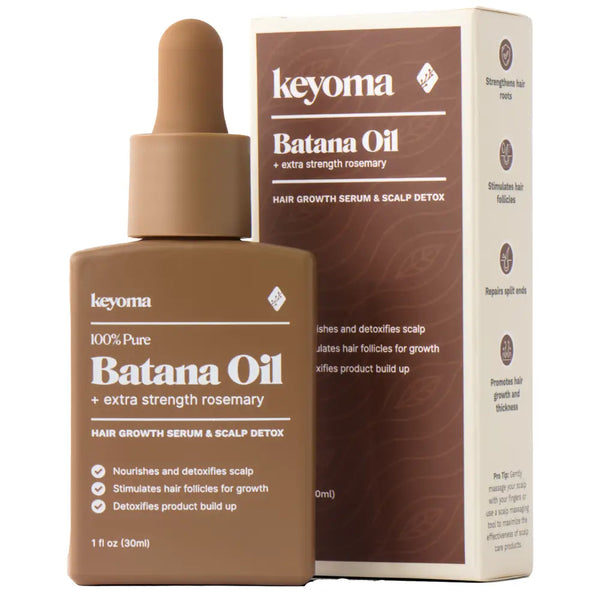
- 30-day supply $50
- 30% off for life $6
- Free haircare essentials kit $33
- Free custom wooden comb $10
- Free scalp massager $15
- Free eco-friendly travel bag $8



